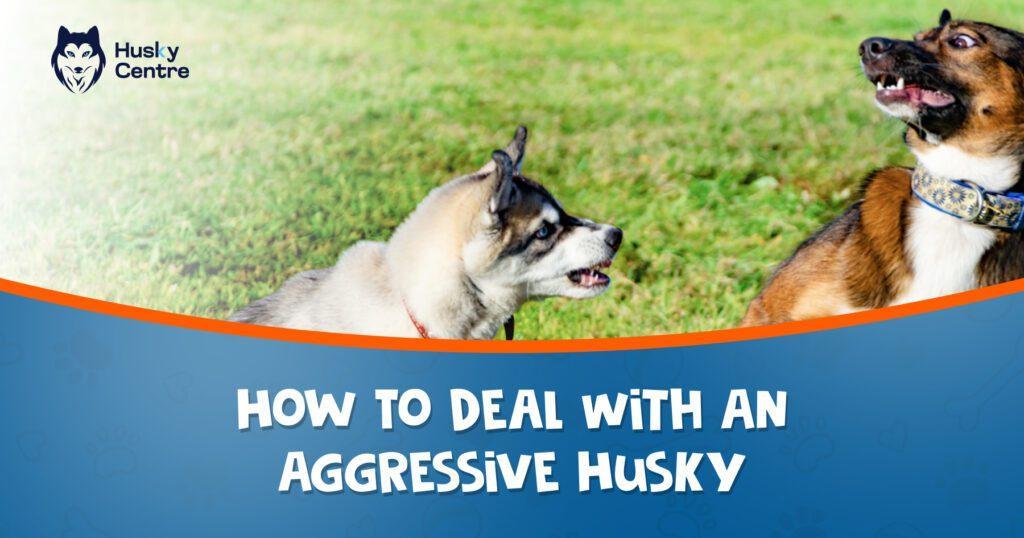Dealing with an aggressive husky requires understanding the root cause and working with a professional trainer to address the behavior effectively. Huskies may exhibit aggression due to fear, dominance, or territorial issues.
Working with a reputable dog trainer can provide you with the tools and techniques to address this behavior in a safe and effective manner. Introducing positive reinforcement methods and teaching your husky appropriate ways to interact with people and other pets can also help manage their aggression.
Furthermore, providing regular exercise, mental stimulation, and a consistent routine can help alleviate stress and reduce aggressive tendencies in your husky. By incorporating these strategies, you can create a harmonious and safe environment for both your husky and those around them.
Understanding Aggression In Huskies
Huskies are known for their striking appearance and affectionate nature, but they can also exhibit aggressive behavior if not properly trained and understood. Understanding aggression in Huskies is crucial for owners to effectively manage and address any aggressive tendencies that may arise.
By delving into the nature of Huskies and learning to identify signs of aggression, owners can proactively address and mitigate aggressive behaviors, ensuring a harmonious relationship with their beloved pets.
The Nature Of Huskies
Huskies are energetic, intelligent, and independent dogs that were originally bred as sled dogs. They have a strong pack mentality and exhibit a high prey drive. Due to their independent nature, Huskies may challenge their owners for dominance if not provided with proper leadership and guidance.
Their strong-willed nature requires consistent training and boundaries to prevent behavioral issues, including aggression, from emerging.
Identifying Aggression In Huskies
Aggression in Huskies can manifest in various ways, including growling, baring teeth, snapping, or lunging. It’s crucial for owners to recognize and address early warning signs of aggression to prevent escalation.
Factors such as fear, frustration, or resource guarding can trigger aggressive behavior in Huskies, making it essential to identify triggers and implement appropriate behavior modification techniques. Understanding the specific triggers and body language of an aggressive Husky is pivotal to effectively managing and curbing aggressive tendencies.
Establishing Leadership And Trust
To establish leadership and trust with an aggressive husky, it’s important to remain calm and assertive. Consistency in training and setting clear boundaries will help the husky understand its place in the pack. Building trust through positive reinforcement and patience is essential for addressing aggressive tendencies in huskies.
Establishing Yourself As The Alpha
When dealing with an aggressive Husky, it is crucial to establish yourself as the alpha or pack leader. This is essential for gaining control over your Husky and maintaining a safe environment for everyone involved. Remember, Huskies are naturally pack animals and will look to the alpha for guidance and direction.
To establish yourself as the alpha, there are a few key steps you can take:
- Show confidence and assertiveness in your actions towards the Husky.
- Set clear boundaries and rules that the Husky must follow.
- Consistently enforce these rules and ensure they are implemented effectively.
- Do not tolerate any challenging or dominant behaviors from your Husky.
Building Trust Through Positive Reinforcement
Building trust with your aggressive Husky is crucial in addressing their aggressive behavior. Positive reinforcement is a highly effective method for building trust and encouraging positive behaviors in your dog.
Here are some ways you can use positive reinforcement to build trust with your Husky:
- Reward your Husky with treats, praise, and affection when they display calm and non-aggressive behavior.
- Use clicker training or verbal cues to mark and reward desirable behaviors.
- Be consistent in your rewards and make sure to provide them immediately after the desired behavior is displayed.
- Avoid using punishment or harsh corrections, as this can erode trust and escalate the aggression.
- Be patient and understanding, and acknowledge any progress made by your Husky.
Training And Socialization Techniques
Huskies are intelligent and energetic dogs, but they can also be prone to aggressive behavior if not properly trained and socialized. As a responsible pet owner, it is crucial to implement training and socialization techniques to ensure your Husky grows up to be a well-behaved and friendly companion. This section will explore effective methods for obedience training and socializing your Husky with people and animals.
Obedience Training Methods
Obedience training is essential to establish boundaries and teach your Husky how to behave appropriately. With consistency and patience, you can instill good manners in your furry friend.
Here are some effective obedience training methods:
- Positive reinforcement: Reward your Husky with treats, praise, and affection when they exhibit desired behaviors. This will encourage them to repeat those behaviors.
- Consistency: Set clear rules and expectations and be consistent in enforcing them. This will help your Husky understand what is acceptable and what is not.
- Clicker training: Use a clicker to mark desired behaviors, followed by a reward. The clicking sound helps your Husky associate the behavior with the reward.
- Redirecting: If your Husky displays aggressive behavior, redirect their attention to a more appropriate activity or command.
- Patience: Training takes time, so be patient with your Husky. Celebrate small victories along the way and never resort to punishment or harsh methods.
Socializing Your Husky With People And Animals
Socialization plays a crucial role in shaping your Husky’s behavior and temperament. Exposing them to various people and animals from an early age will help them develop into friendly and well-adjusted dogs.
Follow these tips to socialize your Husky:
- Early exposure: Introduce your Husky to different people, including children, adults, and seniors. This will help them become comfortable with various age groups.
- Gradual exposure: Start socializing your Husky in controlled environments and gradually expose them to new situations, such as busy parks or dog-friendly events.
- Positive experiences: Ensure that your Husky has positive interactions with people and animals. Monitor their reactions and provide rewards for good behavior.
- Professional training: Consider enrolling your Husky in obedience classes or hiring a professional trainer to assist with socialization efforts.
- Supervised playdates: Arrange playdates with other well-behaved dogs to help your Husky learn proper social cues and behavior.
By implementing these training and socialization techniques, you can help your Husky become a well-mannered and friendly member of your family. Remember, consistency, positive reinforcement, and patience are key to a successful training journey with your Husky.


Credit: pettable.com
Managing Aggressive Behavior
Dealing with an aggressive Husky can be a challenging and potentially dangerous situation. It is important to approach the issue with caution and understanding to ensure the safety of both you and your pet.
By recognizing triggers for aggression, using calming techniques, and providing distractions, you can effectively manage your Husky’s aggressive behavior.
Recognizing Triggers For Aggression
Understanding what triggers your Husky’s aggression is the first step towards managing their behavior. Recognizing these triggers allows you to avoid or address them proactively. Common triggers for aggression in Huskies may include:
- Fear or anxiety-inducing situations
- Territorial or possessive behavior
- Protective instincts towards family members
- Aggression towards other pets or unfamiliar animals
By identifying these triggers, you can create a safer environment for your Husky and take appropriate measures to prevent aggressive outbursts.
Using Calming Techniques And Distractions
When you notice signs of aggression in your Husky, it is essential to stay calm and avoid escalating the situation. Here are some effective calming techniques and distractions you can use:
- Remove the Husky from the triggering situation or environment.
- Create a quiet and safe space for your Husky to retreat to when feeling overwhelmed.
- Practice positive reinforcement techniques, rewarding good behavior and redirecting negative behavior.
- Engage your Husky in mental and physical stimulation through activities like puzzle toys, obedience training, or interactive play.
- Use calming aids such as pheromone diffusers or herbal remedies recommended by your veterinarian.
By implementing these calming techniques and providing distractions, you can help your Husky relax and redirect their focus away from the triggers.
Frequently Asked Questions For How To Deal With An Aggressive Husky
How Can I Calm Down An Aggressive Husky?
To calm down an aggressive Husky, try removing them from the situation that triggered the aggression and provide a safe, quiet space. Use positive reinforcement training techniques and avoid punishment. Consult a professional dog trainer for guidance.
What Are Common Triggers For Husky Aggression?
Common triggers for Husky aggression include fear, territorial instincts, lack of socialization, pain or illness, and resource guarding. Understanding these triggers can help you prevent or address aggression in your Husky.
Can Aggression In Huskies Be Trained Out?
Aggression in Huskies can be managed and improved through proper training techniques, consistent socialization, and positive reinforcement. However, complete elimination of aggression may not always be possible. Seek professional help if needed.
Why Is My Husky Suddenly Aggressive?
Sudden aggression in Huskies can be caused by various factors, such as fear, pain, illness, or a change in their environment or routine. It’s important to identify the underlying cause and address it appropriately to help your Husky overcome aggression.
Conclusion
To wrap it up, dealing with an aggressive Husky requires patience, consistency, and understanding. By implementing the techniques discussed in this guide, you can establish a harmonious relationship with your furry friend and ensure a safer environment for everyone involved.
Remember, avoiding punishment and focusing on positive reinforcement is key. Start implementing these strategies today and witness the transformation in your Husky’s behavior. Happy training!


Meet Jarred, the heart and soul behind HukyCentre. With a deep affection for furry friends, he pours his passion into every word he writes. His genuine love for dogs shines through in his engaging and informative content. As a dedicated dog enthusiast, Jarred’s goal is to share valuable insights and tips that resonate with fellow dog lovers. Join Jarred on the journey as he celebrates the joy and companionship that dogs bring into our lives.



